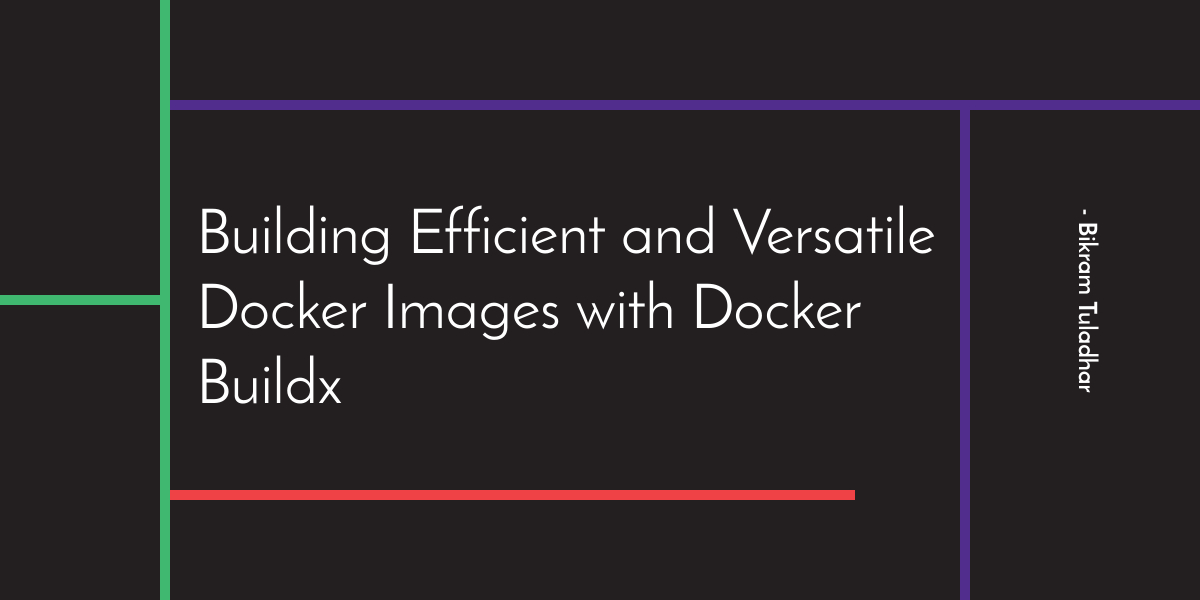Building Efficient and Versatile Docker Images with Docker Buildx
 Bikram Tuladhar
Bikram Tuladhar
Docker is an essential tool for modern developers, allowing for the creation, deployment, and management of containerized applications. One of the powerful features of Docker is Docker Buildx, an experimental CLI plugin that extends the functionality of docker build. This blog will guide you through an interactive journey of leveraging Docker Buildx to create and manage builders, focusing on the commands:
docker buildx create --name local_remote_builder --node local_remote_builder --node intelarch --platform linux/amd64,linux/38 --driver-opt env.BUILDKIT_STEP_LOG_MAX_SIZE=10000000 --driver-opt env.BUILDKIT_STEP_LOG_MAX_SPEED=10000000
docker buildx create --name local_remote_builder --node aarch6 --append --platform linux/arm64,linux/riscv64,linux/ppc64le,linux/s390x,linux/mips64le,linux/mips64,linux/arm/v8,linux/arm/v7,linux/arm/v6 ssh://user@xxx.xxx.xxx.xxx --driver-opt env.BUILDKIT_STEP_LOG_MAX_SIZE=10000000 --driver-opt env.BUILDKIT_STEP_LOG_MAX_SPEED=10000000
docker buildx use local_remote_builder
Step-by-Step Guide to Using Docker Buildx
Step 1: Create a New Builder with Multiple Nodes
Creating a builder with multiple nodes allows you to build images for various platforms simultaneously. Here, we create a builder named local_remote_builder with nodes for different architectures.
docker buildx create --name local_remote_builder --node local_remote_builder --node intelarch --platform linux/amd64,linux/38 --driver-opt env.BUILDKIT_STEP_LOG_MAX_SIZE=10000000 --driver-opt env.BUILDKIT_STEP_LOG_MAX_SPEED=10000000
Breakdown:
--name local_remote_builder: Names the builder instance.--node local_remote_builder: Adds a node to the builder.--node intelarch: Adds another node, targeting Intel architectures.--platform linux/amd64,linux/38: Specifies the platforms for the build.--driver-opt env.BUILDKIT_STEP_LOG_MAX_SIZE=10000000: Sets the maximum log size for the build steps.--driver-opt env.BUILDKIT_STEP_LOG_MAX_SPEED=10000000: Sets the maximum log speed.
Step 2: Append More Platforms to Your Builder
To support even more platforms, you can append additional nodes to your existing builder. Building ARM architecture images on an AMD CPU can be very time-consuming, so it's more efficient to use an ARM instance and access Docker remotely via SSH.
docker buildx create --name local_remote_builder --node aarch6 --append --platform linux/arm64,linux/riscv64,linux/ppc64le,linux/s390x,linux/mips64le,linux/mips64,linux/arm/v8,linux/arm/v7,linux/arm/v6 ssh://user@xxx.xxx.xxx.xxx --driver-opt env.BUILDKIT_STEP_LOG_MAX_SIZE=10000000 --driver-opt env.BUILDKIT_STEP_LOG_MAX_SPEED=10000000
Breakdown:
--append: Appends new platforms to the existing builder.ssh://user@xxx.xxx.xxx.xxx: Specifies the remote SSH endpoint for the build node.
Step 3: Use the Newly Created Builder
After setting up your builder, you need to specify it as the active builder.
docker buildx use local_remote_builder
This command activates the local_remote_builder for subsequent build operations.
Conclusion
Docker Buildx is a powerful tool that enhances the standard docker build command, enabling efficient multi-platform builds. By following the steps outlined above, you can create versatile builders that cater to various architectures and platforms, ensuring your applications are robust and widely deployable. Utilizing ARM instances for ARM builds ensures efficiency and saves time, allowing for a smoother development process.
Interactive Component
To further understand these commands, you can run them in a Docker-enabled environment and observe how each step contributes to the build process. Feel free to tweak the parameters and explore different configurations to see how they affect your builds.
Additional Resources:
Happy building!
Subscribe to my newsletter
Read articles from Bikram Tuladhar directly inside your inbox. Subscribe to the newsletter, and don't miss out.
Written by

Bikram Tuladhar
Bikram Tuladhar
I'm a tech enthusiast who loves to explore DevOps and Web development.